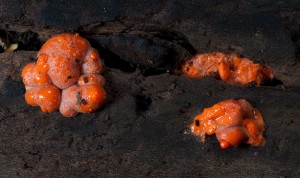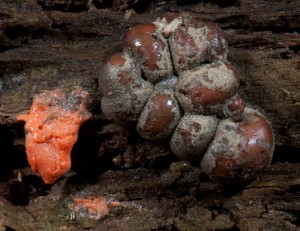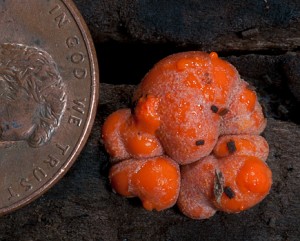Slime Molds are bizarre life forms that were classified as fungus but are now placed in their own kingdom. At one time, every living thing was placed in either the plant or animal kingdom. Currently, most scientists recognize six kingdoms: Plants, Animals, Protists (slime molds and algae), Fungi, Archaebacteria (bacteria found mainly in thermal vents), and Eubacteria; the remaining bacteria.
Slime molds belong in the phylum Myxomycota. John Tyler Bonner writes, “[Myxomycetes are] no more than a bag of amoebae encased in a thin slime sheath, yet they manage to have various behaviors that are equal to those of animals who possess muscles and nerves with ganglia—that is, simple brains.”
The life cycle is complex. An over simplified description of the life cycle is that the spores develop into single cell organisms that then congregate into a fruiting mass producing spores. (If you desire a technical description of the life cycle see the UBC Botanical Garden Website)
Wolf’s Milk Slime Mold (Lycogala epidendrum) is also called Toothpaste Slime Mold. It is circumpolar in the northern hemisphere, ranging throughout Michigan. The fruiting bodies congregate on logs (epidendrum means growing on logs), normally in the fall in Michigan. This is a slow moving slime mold taking days to change shape.
The small size of this slime mold makes it easy to overlook but its bright orange color draws your eye. It is easy to mistake this slime mold for a developing fungus of some kind. After a few days this bright orange color becomes chocolate brown and the slime mold disperses spores. Get out and look for it before the days get too cold.




I have something that looks like wolfs milk slim mold growing on the side of my house, although what we have is much bigger roughly 1.5-2″ in diameter, and is more of a burnt orange color. When I scraped them off, there are holes underneath which seem to indicate some sort of insect. The damage looks very much like a woodpecker snacked on it, but there were no holes prior to the orange lumps appearing. Anyway I was wondering if you could help me identify what is poking holes in my siding and how I might get rid of it.
Wolf’s Milk Slime Mold would not be as big as 1.5 inches. It also would not damage the wood. From your description it sounds as if it is some kind of fungus. Cleaning it off and washing the area might help. But I’m not sure what caused the damage.
I seem to have this in the mulch of my garden near my house and a wooden deck. Is it likely to move/multiply and ruin my deck? If so what can I do to get rid of it?
Once a slime mold reaches the fruiting stage it has all the nutrients required. They like to form at a higher point to disperse spores. Such as the top of a mulch pile, or a raised stump. They prefer to be on rotting wood. It is likely that you will never see them again.